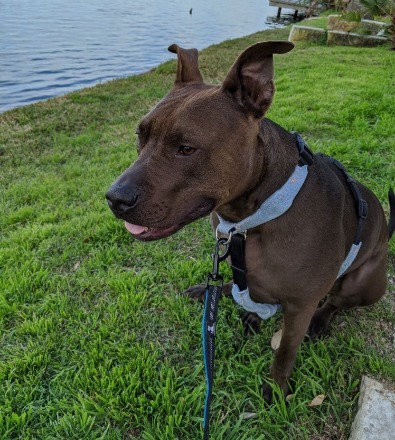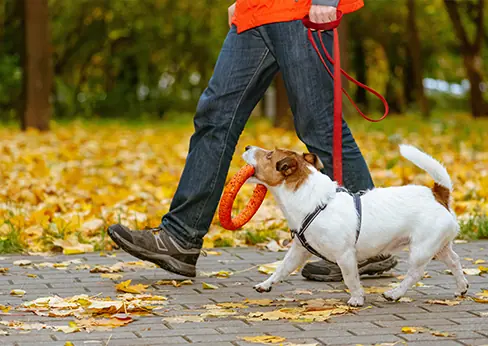Dog Walking Equipment
In this post:
- Chains, prong collars, and e-collars
- Retractable leashes
- Harnesses
- Our Recommendation
Walks are incredibly important for your new best friend. It provides exercise, enrichment, training opportunities, and a bonding experience for you and your dog. But you need to make sure you have the best tools to ensure a positive and safe walk for both you and your dog.
Chains, prong collars, and e-collars
We at Wag Enabled strongly discourage the use of these collars. They can cause a lot of harm to your dog and your relationship with your dog.
Dr. Sophia Yin, DVM MS has an amazing article about choke chains and pinch collars. She strongly cautions against using them because of the harm that they can cause to your dog and their inability to properly fix unwanted behaviors.
An an article by Dr. Peter Dobias, DVM attributes hypothyroidism, ear and eye issues, foreleg lameness, and neck injuries to the use of choke and prong collars.
The APDT (UK) has a code of conduct that states that “coercive or punitive techniques and/or equipment should not be used, recommended, advertised or sold by members” and this includes the shock collar which they describe as an “abusive device.”These tools can affect your dog’s ability to recall tasks in training exercises, which fully negates the training and isn’t useful to anyone in the situation.
Another article from Companion Animal Psychology found that most owners did not read instructions before using a shock collar on their dog and that dogs showed high levels of cortisol when just seeing the shock collar – which means that they were stressed out. The biggest find was that dogs who were “trained” using shock collars did worse at recall exercises (come, don’t chase, etc) than dogs who were trained with positive reinforcement.
Retractable leashes
While retractable leashes appear to have the pro of allowing your dog more freedom to sniff and explore their environment without the danger of being off-leash, there are more cons than pros.
I do not recommend these leashes. If your dog is too far ahead of you, you have the potential to run into a dangerous situation. You cannot grab the leash to pull your dog away from it. If you do grab the leash, or it gets tangled around you or your dog, it can leave some bad burns, cuts, or in more serious cases, amputations.
Dr. Karen Becker wrote a great article on why she does not recommend retractable leashes. They can be very harmful to your dog. The biggest issue is the jerk on the dog’s neck when they run out the leash. The pressure on the neck can cause damage to the trachea and the esophagus. The dog’s throat is very fragile and this pressure can cause a lot of damage.
Retractable leashes can also be dangerous to the dog owner. Because the leash is a thin cord that can easily get tangled around you, it can result in burns, cuts, and even amputation. In 2007 there were 16,564 hospital-related injuries caused by leashes. Consumer Reports suggests that they were caused by retractable leashes.
A retractable leash encourages your dog to pull. Because the dog has so much freedom to walk around, you can’t teach your dog to not pull. In fact, it’s arguable that the leash rewards your dog for pulling by allowing them more distance away from you. Because of this, if you ever have to keep your dog by your side, you will not be able to as your dog is so used to pull you.
Harnesses
According to the Journal of the American Hospital Association, the pressure generated from the collar actually raises pressure on the dog’s eyes. Pulling on your dog and jerking on your dog if your dog lunges, can cause a lot of pain on their trachea, spinal cord, vertebral discs, and esophagus. Buckle collars are best for keeping ID tags or other owner information on them.
It is recommended to use a harness on your dog instead unless. A harness is a great alternative to using a collar because it takes the pressure off the dog’s neck. It also gives you better control because the dog can’t slip out – unless your dog is Houdini.

Back-Clip Harnesses
A back clipping harness should be used on dogs who already know how to walk nicely on a loose leash.
According to Dr. Sophia Yin, harness that hooks up on the back “help train your dog to ignore you and pull you because when you pull on the leash to try to gain some control, they direct the dog’s attention away from you.”
Font-Clip Harnesses
This type of harness takes the pressure off the dog’s sensitive neck. Because the leash is pulling from a ring on the chest, his center of balance is changed and he cannot pull. When he tries, he is forced to turn towards you instead of going forward. This is a great tool for a dog who is pulling, without it he can use his full force to pull against you.

Our Recommendation
I use Blue-9 Balance Harness Buckle-Neck on Truffle. One thing that we noticed with other front clip harnesses is that they interfere with the dog’s natural gait. Normally this isn’t as much of an issue unless you are running with your dog or hiking. You want your dog to have a full range of motion, which this harness allows for.
This is also a SUPER adjustable harness for every dog body shape!
Also, it was one of the few harnesses that also has a back clip for when I do want Truffle to pull – Fly Dog competitions!
The only downfall of this harness (and most harnesses) is that it can rub on his skin because he doesn’t have a lot of fur. This is why I simply added felt to the harness.
Final Thoughts
Most dogs “live for walkies.” My dogs go absolutely crazy when I reach for their leashes, so it’s easy to tell that it’s a highlight of the day. But part of the reason why it’s such a positive experience is that I focus on using the proper collars, leashes, and harnesses for them. My dogs know not to pull because I spent time training them on how to walk on a harness, ensuring that “walkies” remain a joyful and exciting way to promote exercise and enrichment in all of our lives.





